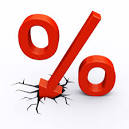Ever hear of a monetary policy by which companies and households get paid to borrow and charged to save money? Seemingly crazy, this negative interest rate policy (“NIRP”) continues to spread around the globe much like a virus, having already infected central banks in Europe, Japan and other countries accounting for 25% of the global economy. (Thus far, Federal Reserve Chair Yellen has indicated no plans to implement a NIRP in the USA.)
A negative interest rate means the central bank, and possibly private banks, will charge negative interest (i.e., below zero percent), so that instead of receiving interest on deposits, depositors must pay to keep their money with the bank. The policy aims to incentivize banks to lend money more freely, and businesses and individuals to invest, lend, and spend money rather than pay a fee to keep it safe. Unfortunately, scant evidence exists to support this outlandish policy – suggesting it could just as easily boomerang. While encouraging lending in theory, negative interest rates squeeze bank profit margins, making them less willing to extend loans. If, conversely, banks try passing on negative rates to depositors, those companies and households may simply withdraw their money, stuffing it under the proverbial mattress and denying banks a crucial funding source.


